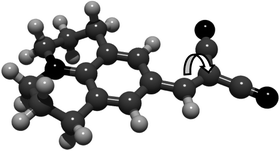The photophysical properties of a julolidene-based molecular rotor
Abstract
The photophysical properties of 9-dicyanovinyljulolidine are sensitive to solvent viscosity but are little affected by changes in polarity. In fluid solution, the lifetime of the first-excited singlet state is very short and triplet state formation cannot be detected by laser flash photolysis. Decay of the excited singlet state is strongly activated and weak phosphorescence can be observed in a glassy matrix at 77 K. Temperature dependent 1H NMR studies indicate that the molecule undergoes slow internal rotation in solution, for which the activation energy has a value of ca. 35 kJ mol−1. This process is unlikely to account for the poor fluorescence quantum yield found in fluid solution. Instead, it is considered that the target compound undergoes rapid rotation around the dicyanovinyl double bond from the excited singlet state. The rate of rotation depends weakly on the viscosity of the solvent in a range of linear alcohols at room temperature. This might represent the fact that the rotor is relatively small and can pack into cavities in the solvent structure. In glycerol, the rate of rotation is more sensitive to viscosity effects but a quite complex temperature dependence is observed in ethanol. Here, the rate is almost activationless in a glassy matrix and in fluid solution at high temperature but strongly activated at intermediate temperatures.


 Please wait while we load your content...
Please wait while we load your content...